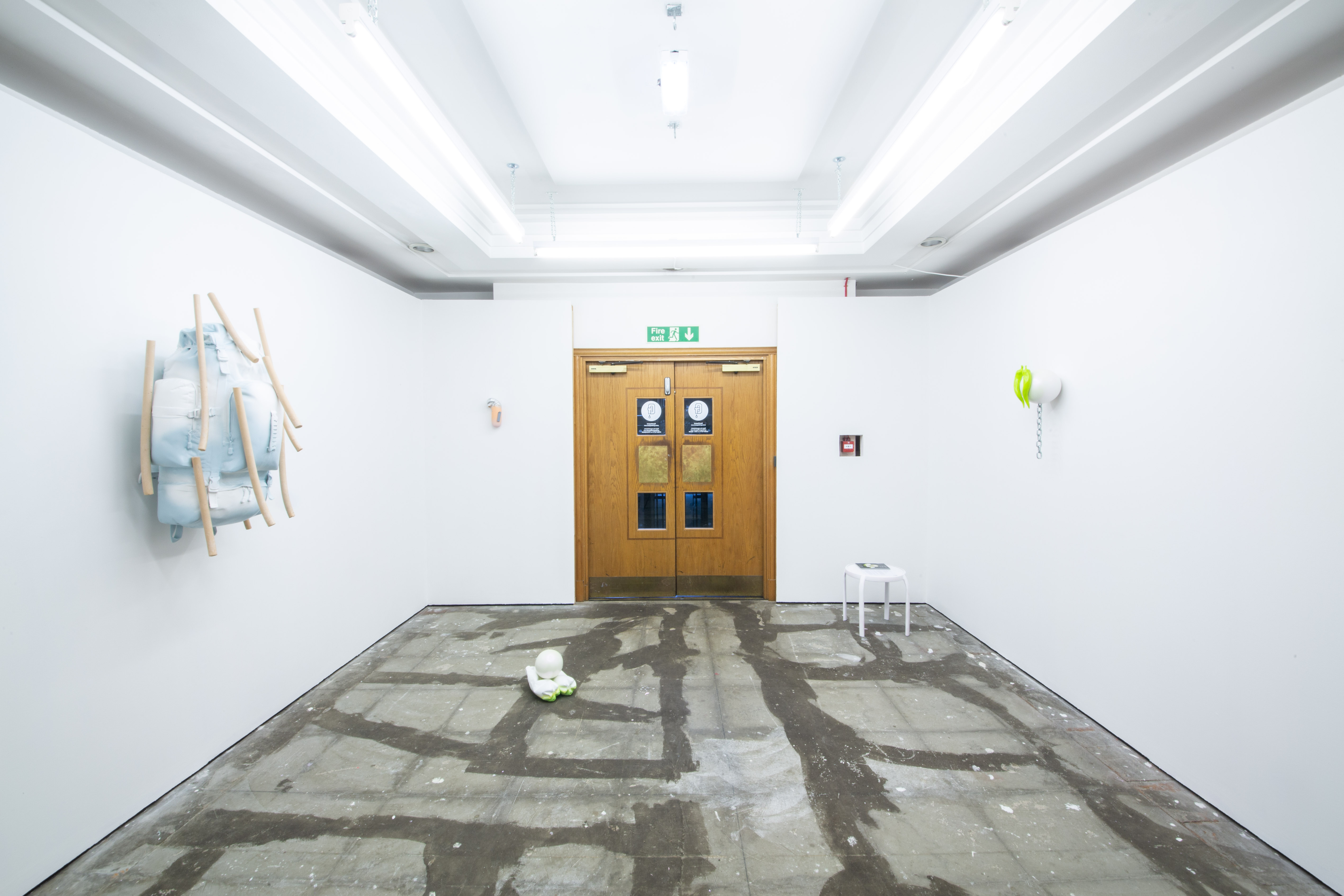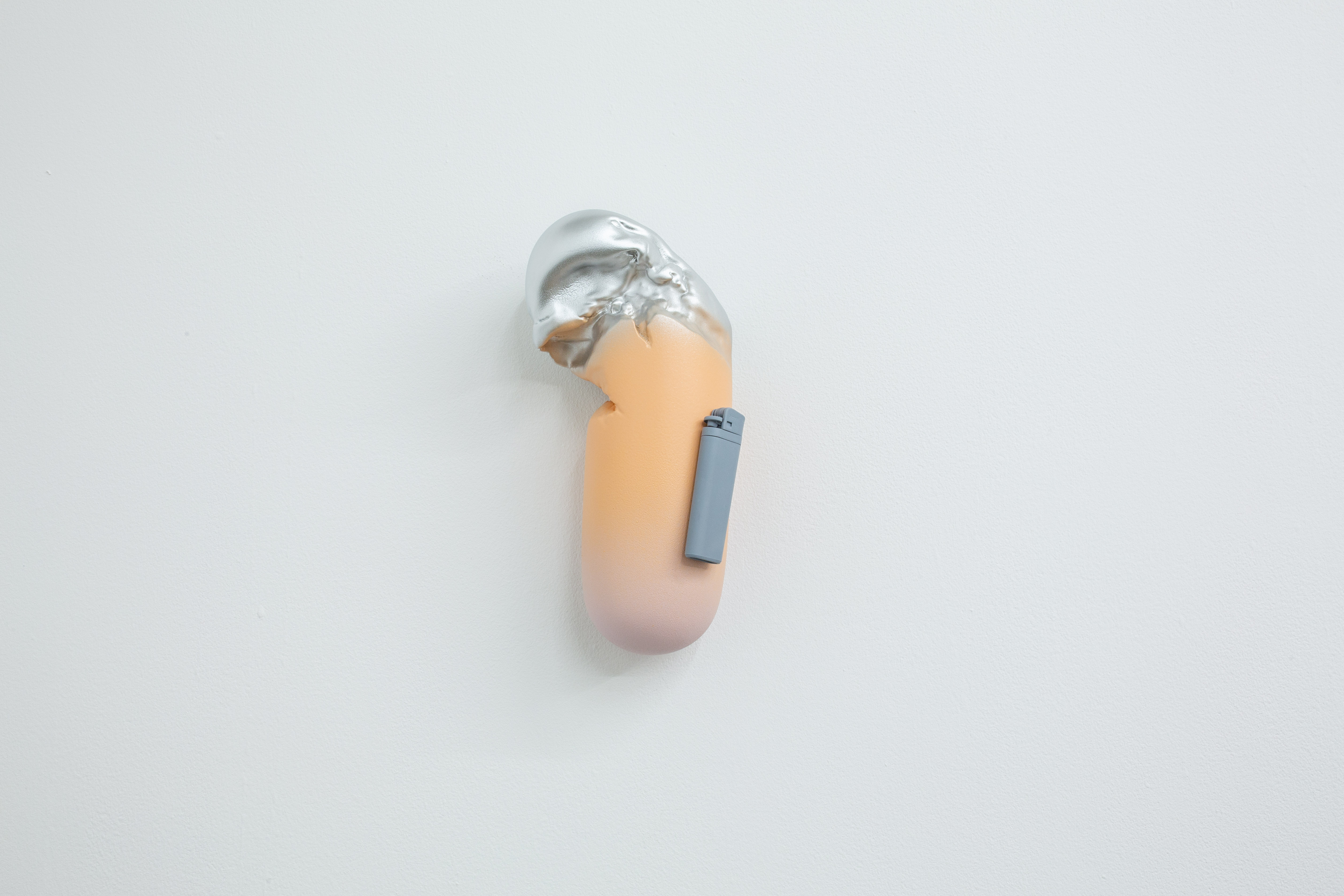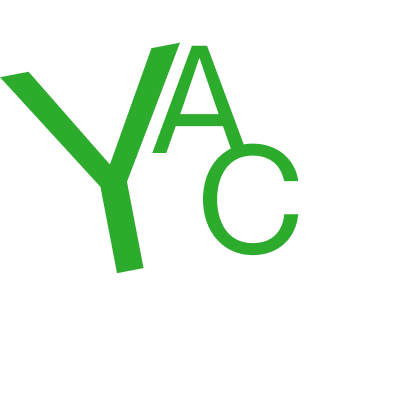Richard Hughes
Interview by Jessica Bennett
-
Published January 2019
-
This interview is a conversation between artist Richard Hughes and curator Jessica Bennett following Hughes’ exhibition No Cigar at GOLDTAPPED in Newcastle (October –Nov 2018).
Hughes is an artist based at Paradise Works, Salford.
-
Hi Richard! How’s it going? It has been great working with you on No Cigar and to see the exhibition come together! Firstly, for those who do not know you and your work, I thought I’d start by asking if you could give an overview about yourself, your practice and the work you do?
Hi, well I live in South Manchester and I make work pro-dominantly in my studio located at Paradise Works in Salford. My ideas manifest themselves mostly through sculptural works. I am very driven by materiality and use a lot of industrial materials such as resin, concrete and plaster. I treat the surfaces of my works with care and try to produce works that feel as though they have a function, playing with ideas of manufacturing and commerciality.
In terms of the concepts and ideas behind the work, I am very susceptible to change and influence but I frequently engage with ideas of legacy and time. I find myself thinking about our relationship with memory, my works act as some kind of memorial or landmark within my own history; when I say history I mean as in a kind of reflection of the whole. I draw from imaginary scenarios of the future which are evidently, through the idea of schemata, developed from my own experiences as well as current social and global situations. I find it interesting to try and describe the situations that I feel I may find myself in the future. I use this as a process to develop imagery and consciously source objects and materials that may belong in this space or time.

There is a real contrast between this idea of history/legacy as well as scenarios for your future self, I can see how this resonates within your work… Could you tell me a bit about your most recent solo show No Cigar at GOLDTAPPED?
When putting together the show I was interested in the function of art and object, I tried to make and select work that can be viewed individually but lend themselves or play a part in a larger narrative. The main premise of the show is survival and scenario, you could say coping mechanisms to endure current personal and global issues alongside a somewhat dystopian view of the future.
For No Cigar I wanted to create a strange and quite chaotic sequence, conceptually each piece is hopefully reactive to each other, for example, Losing All the Happy People depicts an act of violence or aggression, and other works could be responsive as they depict ideas of fleeing (Far From the Silver Lining) physical harm (Throats) and death (Dead End Desires) so I guess I was interested in the language of the sculptures I make and how they, through visual language, can tell a story, what the story is exactly I am still exploring.
Could you give an example of a piece of work from the show and your thought process behind it?
Well in some works I try to create a kind of collisional narrative, I do this by using contrasting materials and objects as well as colours that could be suggestive of the environment in which the object could be, for example, the temperature of the colour I use as well as the way it is applied such as mists and fades can in some way emulate fog or steam. The object may be dipped and the paint built up as though they lay in some kind of glutinous swamp, basically using paint to describe the interaction between the objects surface and the environment.
The work Far From The Silver Lining may be a good example of this, the work is made up of a large 120 litre rucksack, packed and stuffed and then dipped in resin as well as having resin poured over the surface to almost entomb it, features of the bag were then disguised and embedded into the main body of the bag using car body filler which I then smoothed and sanded, I did this to suggest some kind of transition or change. The object was then adorned with these long plaster objects, which I like to think of as a collection, as though taken and picked up over time, rather like memories.
I was also interested in the idea of contents, in this case being displayed on the outside rather than on the inside. These plaster objects were bathed in a vat of Castrol engine oil, to be absorbed by the plaster which gave a strange, aged but greasy texture and patina, I also used this material because the oil is a material suggestive of our time as well as the future, fuel. So within the one work, I was thinking about what we bring with to the present from the past and how this effects (along with universal and global issues) our interaction and journey into the future.

From the processes you’ve talked about and the work itself, you are very hands-on. It is clear that there are many different methods and techniques you use to get to the final piece.
I must say as a curator, it was exciting to see your newest work Far From The Silver Lining. Being part of the installation process, it was intriguing to see the subtle nuances you wanted from each piece. Could you tell us more about the long process to get the final piece? From the idea - to the making - or is there a method you try and stick to?
I stick to no method or at least I don't feel I have a rigid method of producing work. I guess the longest process is the visualisation, I have lots of ideas and I guess I naturally filter through them and disregard those that don't either correlate with what I'm trying to say, excite me or seem to have some kind of mystique that I want to investigate, I must have thousands of forgotten ideas. I then live with that idea for a while and see how it develops in my mind, I change colour and objects and generally carry out a lot of 'what if's.' When I feel that it is something I want or need to make I start to think about how I will start it. I don't get bogged down too much about the finer details but I think about how to produce the main shapes or bulk of the objects, whether it be casting, carving etc.
The sculptures can change through this process for different reasons, mainly to overcome problems I have to come up with alternative methods, sometimes the structure and the form start to determine the surface quality and therefore the material and approach I take, or it could be that the language of the work is different to what’s initially considered and starts to lend itself to other concepts and narratives and I follow where this may lead. The work often develops quickly then slows right down as I get closer to the surface. I have to sand a lot which can be laborious and time-consuming but really transforms the work.

Very much a trial and test method! Speaking of colour, there is a contrast between the metal and clean/polished colours you use as seen in the pearls, to then the bright colours, could you tell me more about your reasoning behind this?
I guess I am interested in the language of objects, I explore the connotations and iconography embedded in the objects I chose to use and represent. There are many reasons why I may chose a particular object within a specific work. It maybe that they tie the work together conceptually for me or that they are a point of access into the place and space in which the whole work represents. It may also be that they offer some attachment to a ritual or sensual experience, or simply that I enjoy the fleshy biological qualities alongside more manufactured or artificial objects and surfaces, kind of like a human made up of cells and blood sat inside a metal car, basic juxtapositions. The choice of object is often secondary to another, as well as the main form in a particular work.

Within your work, you incorporate very natural forms such as chillies and I know some of your previous work had tongues, can you tell me more about why you incorporate these?
In relation to the chillies; for me they kind of belong to two spaces, initially a universal object belonging geographically to a particular place and history but also when used alongside the contexts of the other objects and forms they act as a kind of beacon to another place. They represent desire, for me a desire to be somewhere more exciting and exotic, a break from the mundane nature of life in northern England.

There is a power in the duality. Forgive me if I am going off on a tangent here: would you say it is also a futuristic contrast that even though things will advance such as technology, science etc, fundamentally the human body and living things will 'always be'? I also want to touch on how do you consider using written language in your work?
Yes very much so, although I feel as our bodies, appearance and biology, do change they still represent history and time at a different rate to our surroundings and the planet. Within my work I feel I am more interested in the change of the idea of ‘self’ and I think about how emotions such as empathy will manifest and change in a world in constant crisis, how will our morals and identities change when everything is diluted and artificial. I feel that I try to suggest our vulnerability in the work, emphasising our softness in contrast to the hostility of the modern world. This is from a male perspective.
I have used written text in my work a great deal, from works such as My Fathers Heroes Are All Dead and Just Try Not to Think about It. For me now the written works are very much a starting point and can plunge me into a world that the text and words are describing. In many ways the sculptures are a way to visualise and emphasise what the text describes. They are indefinitely tied. I am also very interested in using descriptive language when developing titles for the work, in some cases the title comes first and I respond to the words and descriptions physically through form and object. In some cases the words and text are drawn from considerations of the future and brought back, a method I mentioned earlier, this could be conversations that may or may not happen between loved ones for example. This allows me to derive a human and emotional element to the ideas of the future rather than only descriptions of the environment for example.
That is very interesting! Would you say your work is emotionally beneficial for you to deal with the inevitable future or even the past?
Well I think we have to remember that it is only art and that the benefits of producing art are quite unmeasurable but I do feel that my practice allows me to make predictions about my own future and allows me to understand the complexities of the idea of self. I guess it all acts as a kind of documentation of effect, change and perspective, within the lifetime of one individual.
I find this rather intriguing as you speak about your work and in past conversations you have mentioned the idea of being ‘anti-romantic’, can you speak more about this and its relationship to your work?
The idea of the anti-romantic for me is a way of describing the collision between the soulful and emotional aspects of being a human and the cold, commercial capitalist nature of the world, a kind of realism, both exist and cancel each other out in some way. I have always been interested in history, in many ways an idealised, romantic notion of history and I am not sure where this perspective comes from, most likely Hollywood and the media. I try to embed within my work a sense of frustration which is born from the fact that history seems so much more enigmatic, romantic and interesting than the past and in many ways the future, I wonder whether people of older ages thought the same about the history and people that came before them. How do we know our own significance and how will the current moment be received over time as it all becomes more singular. I think due to issues such as climate change and our changing habits that the world is becoming bleaker and this sadness and anxiety is something I am interested in very much.

These are very profound ideas you are touching upon, and highlighting some sombre undertones. Okay so No Cigar tell me more about the title? Which came first: the show or the title?
The title of No Cigar comes from the saying ' Close But No Cigar.' This for me seemed to encapsulate all the things I have been thinking about through its literal meaning and the imagery it conjures up. On the one hand, for me it suggests that you can never ever reach the future, always close but never achieving it because we are constantly in the present. Furthermore it relates to the idea of the anti-romantic, wanting something but never really getting it, being second best. Also it makes me think about machoism, the last parts of the reel from Hollywood disaster movies and the one liners that the lead role may say as he casually avoids a situation that would have undoubtedly killed him or left him in a coma.
I changed the saying and shortened it just 'no cigar,' to reduce the idea of hope within it, for me it very much suggests that we are not even close, again I guess emphasising the darkness and removing the romance.
Yes I understand completely! There is space in the work for the viewer to also question their future or what they think the future might hold (at least I felt like this anyway).
It has just made me question my past and how I view it, there can be a 'glamorised perfect' notion, reminiscing about 'the good old days'? Do you think it is because the future is unknown and unwritten? Do you think the fundamental issues as you said i.e. climate change, political matters ... create more anxiety of the unknown?
I guess I consider scenes and landmarks from my own memory but I try to explore their relationship to the completion of life where it can be viewed as a whole and very much an item or thing. I try to feel what it may be like to be looking back at my own past but from an older futuristic version of myself, or from an outside perspective looking in. I am interested in the idea of life flashing before my eyes during a near death experience, I often wonder what images would flash up and if they would be different to the images I would consciously seek if given the chance.
I try to be responsive to the imagined scenarios in a way that explores the particular moment. I like to think about the moment or reason I would take a photo if I were to be physically able to be in my own future, what would it be that we would want to remember or capture, not from a documentational point of view but something more personal, emotional or even nostalgic. From what you’re asking I would say that the anxiety is developed from the idea that we never really know until it’s gone, in some ways we don't want things to change but we also would not be able to learn and develop if it didn’t.
-
Richard Hughes lives and works in Manchester. Recent exhibitions include No Cigar, GOLDTAPPED, Newcastle, Our Hands Were Always Dirty But Our Minds Were Always Clean, Fallout Factory, Liverpool, Noise Festival 2014 Launch, Curators choice: Tim Marlow. House of Commons, London and A Slow Passion, Federation House: Castlefield Gallery’s New Art Space. Manchester.
-
richardhughesart.com
-
If you like this why not read our interview with Jaf Yusuf
-
© 2013 - 2018 YAC | Young Artists in Conversation ALL RIGHTS RESERVED
